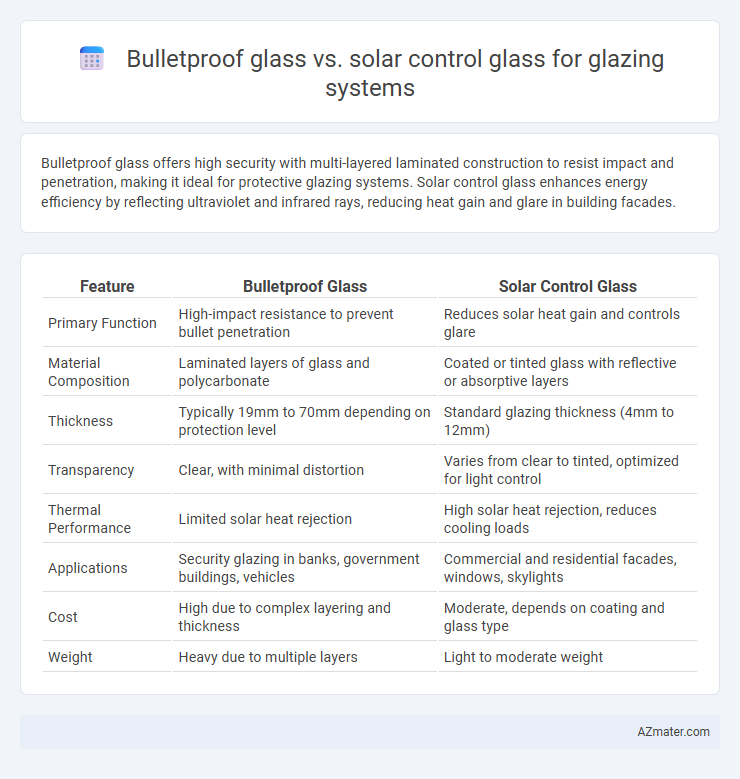Bulletproof glass offers high security with multi-layered laminated construction to resist impact and penetration, making it ideal for protective glazing systems. Solar control glass enhances energy efficiency by reflecting ultraviolet and infrared rays, reducing heat gain and glare in building facades.
Table of Comparison
| Feature | Bulletproof Glass | Solar Control Glass |
|---|---|---|
| Primary Function | High-impact resistance to prevent bullet penetration | Reduces solar heat gain and controls glare |
| Material Composition | Laminated layers of glass and polycarbonate | Coated or tinted glass with reflective or absorptive layers |
| Thickness | Typically 19mm to 70mm depending on protection level | Standard glazing thickness (4mm to 12mm) |
| Transparency | Clear, with minimal distortion | Varies from clear to tinted, optimized for light control |
| Thermal Performance | Limited solar heat rejection | High solar heat rejection, reduces cooling loads |
| Applications | Security glazing in banks, government buildings, vehicles | Commercial and residential facades, windows, skylights |
| Cost | High due to complex layering and thickness | Moderate, depends on coating and glass type |
| Weight | Heavy due to multiple layers | Light to moderate weight |
Introduction to Glazing Systems
Glazing systems incorporate various types of glass to enhance building performance, with bulletproof glass providing high-impact resistance and security, while solar control glass focuses on reducing heat gain and improving energy efficiency. Bulletproof glass offers multilayered protection against ballistic threats, making it ideal for security-sensitive environments. Solar control glass utilizes specialized coatings to reflect infrared radiation, thereby lowering cooling costs and increasing occupant comfort in glazing applications.
Bulletproof Glass: Composition and Features
Bulletproof glass, also known as ballistic glass, consists of multiple layers of laminated glass and polycarbonate designed to absorb and disperse the impact energy from bullets. Its composition typically includes alternating layers of glass and plastic interlayers, providing high resistance to penetration while maintaining transparency. This glass offers superior security features such as impact resistance, shatterproof protection, and durability, making it ideal for high-risk environments in glazing systems.
Solar Control Glass: Composition and Features
Solar control glass is composed of multiple layers including a clear glass substrate coated with thin metallic or ceramic coatings that reflect and absorb solar radiation, significantly reducing heat gain and glare inside buildings. Its features include high visible light transmission combined with low solar heat gain coefficient (SHGC), UV protection to prevent interior fading, and enhanced energy efficiency by minimizing the need for air conditioning. Compared to bulletproof glass, solar control glass prioritizes thermal regulation and comfort without compromising natural light, making it ideal for glazing systems focused on energy savings and occupant comfort.
Applications of Bulletproof Glass in Buildings
Bulletproof glass is primarily utilized in high-security buildings such as banks, government offices, and embassies where protection against ballistic threats is critical. It offers superior resistance to impact and forced entry, making it ideal for secure glazing in areas requiring enhanced safety measures. Solar control glass, by contrast, focuses on energy efficiency and reducing solar heat gain, thus it is more suited for commercial and residential buildings aiming for thermal comfort rather than security.
Applications of Solar Control Glass in Buildings
Solar control glass is widely used in commercial and residential buildings to reduce heat gain and enhance energy efficiency by blocking infrared radiation while allowing visible light transmission. Its applications include facades, windows, curtain walls, and skylights where maintaining natural daylight and minimizing cooling loads are critical. Compared to bulletproof glass, which primarily offers security and impact resistance, solar control glass optimizes indoor thermal comfort and reduces reliance on air conditioning systems.
Energy Efficiency Comparison
Bulletproof glass offers high security but typically has lower energy efficiency due to its thickness and multiple layers, which can reduce solar heat control. Solar control glass is specifically designed with coatings that reflect and absorb solar radiation, significantly improving thermal insulation and reducing cooling costs. For glazing systems prioritizing energy efficiency, solar control glass provides superior performance by minimizing UV and infrared heat transfer while maintaining natural light transmission.
Safety and Security Considerations
Bulletproof glass offers superior ballistic resistance and impact protection, making it ideal for high-security glazing systems in banks, government buildings, and secure facilities. Solar control glass enhances safety by reducing heat gain and glare, thereby preventing overheating and minimizing the risk of accidents caused by excessive solar radiation. Combining both types optimizes security measures while improving energy efficiency and occupant comfort in modern architectural designs.
Cost Analysis: Bulletproof vs Solar Control Glass
Bulletproof glass typically costs 2 to 4 times more than solar control glass due to its multi-layered composition and high-strength materials designed for impact resistance and security. Solar control glass offers a more cost-effective solution by reducing energy consumption through improved thermal insulation and UV protection, thereby lowering long-term operational expenses. When evaluating glazing systems, the upfront investment for bulletproof glass is significantly higher, whereas solar control glass provides economical benefits in energy savings and maintenance.
Aesthetic and Design Flexibility
Bulletproof glass offers robust security while maintaining clarity, but its thickness and weight can limit aesthetic design options in glazing systems. Solar control glass enhances energy efficiency and allows for versatile tinting and coatings, providing greater design flexibility with various colors and reflective properties without compromising visual appeal. Combining both types in a glazing system can balance safety requirements with contemporary architectural aesthetics.
Choosing the Right Glazing System for Your Project
Bulletproof glass offers maximum security and impact resistance, ideal for high-risk environments requiring protection against forced entry or ballistic threats. Solar control glass enhances energy efficiency by reducing heat gain and blocking harmful UV rays while maintaining natural daylight, perfect for sustainable building designs. Selecting between these glazing systems depends on balancing security priorities with energy performance and occupant comfort for your specific project needs.

Infographic: Bulletproof glass vs Solar control glass for Glazing system
 azmater.com
azmater.com